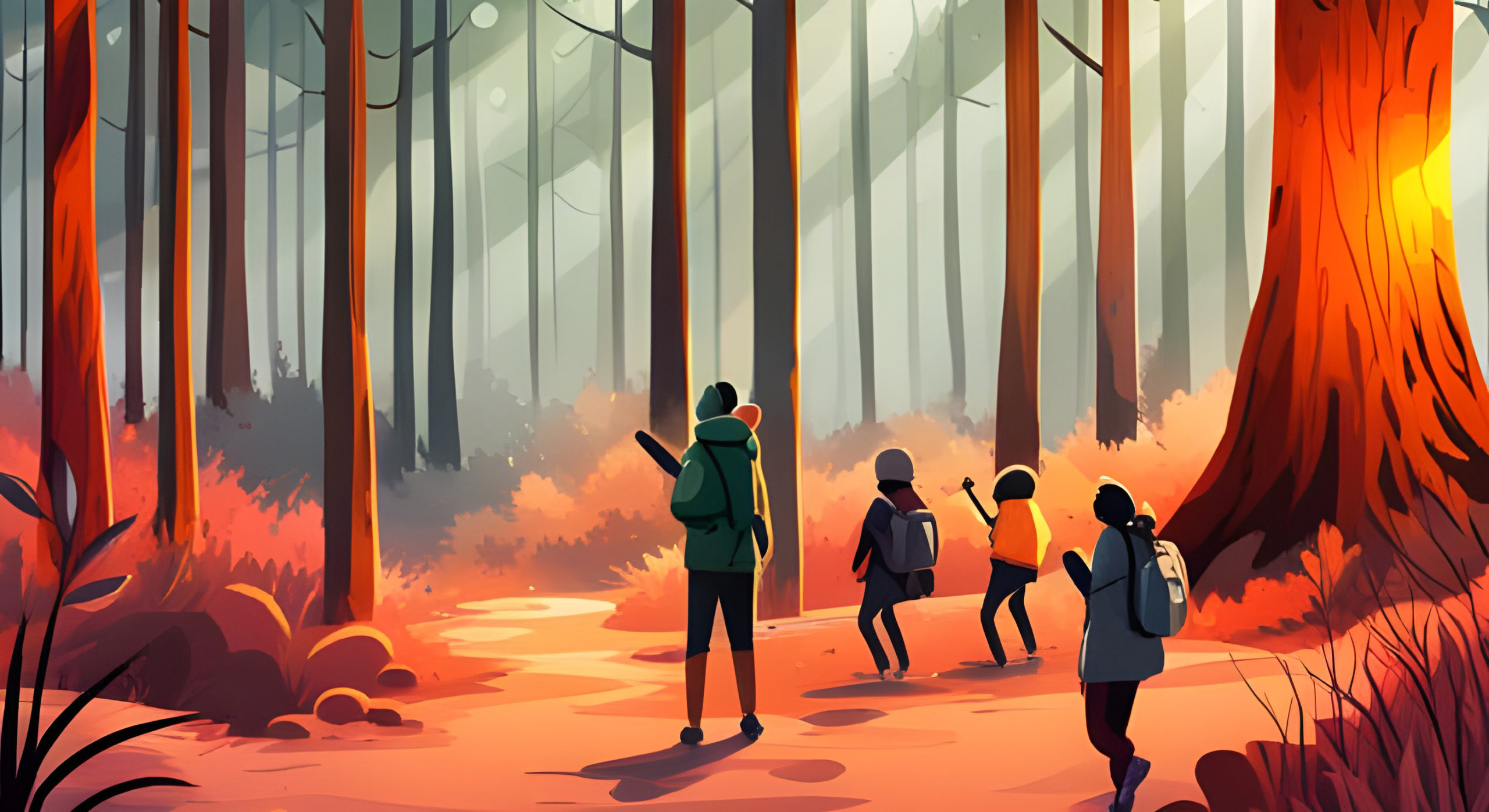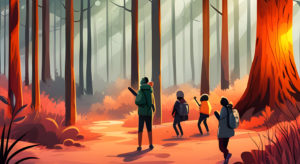Nature’s Classroom: The Power of Outdoor Learning in Boosting Student Well-being and Performance

Table of Contents
Nature as Your Textbook
Step outside the four walls of a traditional classroom and into nature’s classroom, where the transformative power of outdoor learning unfolds. Research has shown that integrating nature into the educational experience can have a profound impact on student well-being and academic performance.
In a world overshadowed by digital clouds, students spend more time indoors and less time in outdoors. Yet, studies have shown that exposure to natural environments can improve concentration, reduce stress and anxiety, and enhance creativity.
Outdoor learning fits perfectly with an experiential learning approach and provides students with a unique opportunity to engage with the natural world, fostering a sense of wonder and curiosity. It allows them to learn in a hands-on and interactive way, making lessons more memorable and exciting. By incorporating nature into the curriculum, educators can tap into the innate connection between humans and the natural world, enhancing learning outcomes and promoting the overall well-being of students.
As the benefits of learning and studying in nature are increasingly recognized, schools around the world are embracing this approach. From nature walks and gardening to experiential learning in wildlife sanctuaries, outdoor education is paving the way for enriched learning experiences that extend beyond the classroom. So, step outside, breathe in the fresh air, and discover the transformative power of nature’s classroom.
The Impact of Nature on Student Well-Being and Mental Health
Spending time in nature has a significant positive impact on students’ well-being and mental health. Research has shown that exposure to natural environments can reduce stress levels, improve mood, and increase self-esteem. The calming effects of nature help students relax and recharge, leading to improved mental well-being.
In addition, being in nature encourages physical activity, which has been linked to better mental health outcomes. Outdoor activities such as hiking, gardening, and playing sports not only promote physical fitness but also release endorphins, the body’s natural feel-good chemicals. This can help alleviate symptoms of depression and anxiety, and improve overall psychological well-being.
Nature also inspires curiosity and creativity, and provides a sense of awe and wonder, stimulating curiosity and creativity. The beauty and complexity of the natural world can inspire students to think outside the box, fostering a sense of wonder and imagination. This can lead to increased motivation, engagement, and a deeper connection to the learning process.
Academic Benefits of Outdoor Learning
Outdoor learning not only improves students’ well-being, it also has numerous academic benefits. Research has shown that exposure to nature can improve cognitive function and academic performance. Students who frequently get outside to learn have better attention spans, improved memory retention, and better problem-solving skills.

The hands-on and interactive nature of outdoor learning makes lessons more memorable and engaging. Students can see, touch, and experience concepts firsthand, which helps them grasp complex ideas more easily. For example, a science lesson on ecosystems can come to life when students explore a local forest, observe different species, and analyze their interactions.
Furthermore, outdoor learning encourages critical thinking and creativity. It provides students with opportunities to apply their knowledge in real-world contexts, fostering a deeper understanding of concepts. Whether it’s conducting experiments in a natural setting or collaborating on a project outdoors, students develop higher-order thinking skills and become active participants in their own learning.
Outdoor Learning and Physical Health
Beyond the mental and academic benefits, learning outdoors promotes physical health. Regular physical activity is essential to maintaining a healthy lifestyle, and outdoor learning provides students with the opportunity to engage in physical activity while enjoying the natural environment.
Outdoor activities such as hiking, biking, and team sports not only improve cardiovascular fitness but also help develop coordination, balance, and motor skills. These physical activities contribute to overall physical well-being and can have a positive impact on students’ long-term health.
Moreover, exposure to natural light and fresh air has been shown to improve sleep patterns and strengthen the immune system. Spending time outdoors increases vitamin D levels, which are critical for bone health and immune function. By incorporating outdoor learning into the curriculum, educators can promote physical health and instill lifelong habits of active living in students.
Incorporating Outdoor Learning into the Curriculum
Integrating outdoor learning into the curriculum requires careful planning and coordination. Educators can begin by identifying opportunities within existing subjects to incorporate outdoor activities. For example, a math lesson on geometry can be taught outdoors using natural objects as manipulatives.
Additionally, partnerships between teachers and outdoor educators or environmental organizations can bring expertise and resources to outdoor learning initiatives. These partnerships can provide access to nature preserves, wildlife parks, and other outdoor spaces that serve as ideal learning environments.
It’s also important to align the activities with specific learning objectives and standards. By clearly defining the desired learning outcomes, educators can ensure that outdoor activities are purposeful and seamlessly integrated into the curriculum.
Tips for Planning and Organizing Outdoor Learning Activities

There are several factors to consider when planning and organizing outdoor learning activities. Here are some tips to make the process more effective and enjoyable:
- Select appropriate locations: Select outdoor spaces that offer diverse ecosystems and opportunities for exploration. Consider the proximity to the school, accessibility, and safety of the location.
- Prepare for varying weather conditions: Outdoor learning activities can take place in a variety of seasons and weather conditions. Make sure students and staff are prepared with appropriate clothing, sunscreen, insect repellent, and other necessary items.
- Put safety first: Conduct a thorough risk assessment of the site to identify potential hazards and ensure student safety. Establish clear guidelines and protocols for students to follow during outdoor activities.
- Incorporate hands-on activities: Engage students in interactive and hands-on activities that allow them to explore and discover the natural world. Encourage them to ask questions, make observations, and record their findings.
- Promote inquiry-based learning: Encourage students to develop their own questions and investigate the answers through outdoor exploration. This builds critical thinking and problem-solving skills.
- Reflect and debrief: After each outdoor learning activity, provide opportunities for students to reflect on their experiences and discuss their observations. This helps to reinforce learning and deepen understanding.
Case studies: Successful outdoor learning programs
Many schools around the world have successfully implemented outdoor learning programs and seen positive results. Let’s explore some case studies:
Forest Schools in Sweden
Sweden’s forest schools have gained international recognition for their holistic approach to education. These schools emphasize outdoor learning and provide students with regular opportunities to explore and learn in natural environments. Research has shown that students who attend forest schools have improved social skills, creativity, and academic performance.
Outdoor Classroom Project in California, USA
The Outdoor Classroom Project in California promotes the use of outdoor spaces for learning and play. This initiative has transformed schoolyards into vibrant outdoor learning environments, complete with gardens, nature trails, and natural play areas. Schools participating in the project have reported increased student engagement, improved behavior, and enhanced academic achievement.
Overcoming challenges in implementing outdoor learning
While outdoor learning offers many benefits, there can be challenges in implementing it. Some common challenges include:
- Time constraints: Incorporating outdoor learning into the curriculum may require additional time for planning, preparation, and travel. This can be a challenge for educators who already have a busy schedules. However, the long-term benefits outweigh the initial time investment.
- Limited access to outdoor spaces: Not all schools have easy access to natural environments or outdoor spaces. However, creative solutions such as community partnerships, virtual field trips, or schoolyard renovations can help overcome this challenge.
- Safety concerns: Keeping student’s safe during outdoor activities is a top priority. Educators must conduct thorough risk assessments, establish clear guidelines, and provide appropriate supervision to minimize risks.
Resources and tools for outdoor learning

Fortunately, there are numerous resources and tools available to help educators implement outdoor learning. Here are a few:
- Nature-based curriculum guides: Many organizations and environmental agencies offer curriculum guides that provide lesson plans and activity ideas for outdoor learning. These resources are aligned with educational standards and make it easier for educators to incorporate nature into their lessons.
- Mobile apps and online platforms: There are several mobile apps and online platforms that provide information about local flora and fauna, weather conditions, and outdoor activity ideas. These resources can enhance the outdoor learning experience and provide additional support for educators.
- Professional development opportunities: Educators can attend workshops, webinars, and conferences focused on outdoor learning to gain new ideas and strategies. These professional development opportunities help educators stay current with the latest research and best practices in outdoor education.
Frequently Asked Questions
1. Is outdoor learning appropriate for all subjects?
Outdoor learning can be integrated into a variety of subjects, including science, math, language arts, and social studies. It provides an opportunity for interdisciplinary learning and helps students make connections between different subjects.
2. How can outdoor learning benefit students with special needs?
Outdoor learning is inclusive and can benefit students with special needs. It provides a multisensory learning experience and allows for individualized adaptations. Being in nature can also have a calming effect on students with sensory sensitivities or behavioral challenges.
3. How can parents support outdoor learning?
Parents can support outdoor learning by encouraging their children to spend time in nature outside of school hours. They can also participate in outdoor activities and field trips organized by the school. In addition, parents can advocate for more outdoor learning opportunities within the school curriculum.
Conclusion: Embracing the transformative power of nature in education
As the benefits of outdoor learning are increasingly recognized, schools around the world are embracing this approach. By integrating nature into the curriculum, educators are tapping into the innate connection between humans and the natural world, improving learning outcomes and promoting the overall well-being of students.
Outdoor learning provides a unique opportunity for students to engage with the natural world, fostering a sense of wonder, curiosity, and connection. It improves student well-being, boosts academic performance, and promotes physical health. By stepping out of the traditional classroom and into nature’s classroom, students can unlock their full potential and embark on a transformative educational journey.
So, step outside, breathe in the fresh air, and discover the transformative power of nature’s classroom.












